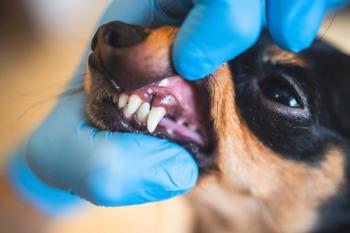
Oronasal fistula closure (Proceedings)
An oronasal fistula is a communication between the oral and nasal cavities that can be a result of periodontal disease, iatrogenic fracture of palatal bone during extraction or traumatic avulsion of a canine tooth.
An oronasal fistula is a communication between the oral and nasal cavities that can be a result of periodontal disease, iatrogenic fracture of palatal bone during extraction or traumatic avulsion of a canine tooth. Symptoms may include chronic sneezing with serous nasal discharge or hemorrhagic nasal discharge. Often they are identified during periodontal therapy with no previous symptoms noted by the owner. This condition should be repaired to prevent passage of food and liquid into the nasal cavity and to stop any chronic nasal infection. Primarily a condition involving dogs, it can also occur in cats.
Method of repair of the oronasal fistula depends on the presence or absence of attached gingiva. If the attached gingiva is present on the buccal mucosa adjacent the fistula, the defect can be corrected using a single sliding mucoperiosteal graft. The margins of the fistula are first debrided of epithelialized or necrotic tissue. Releasing incisions are then made beginning at the mesial and distal margins of the fistula diverging apically into the buccal mucosa. This mucosal flap is elevated utilizing a periosteal elevator. The key to sliding this mucosal flap over the defect is making a horizontal incision at the depth of the flap through the periosteal attachments. When this releasing incision is made, the flap will slide down over the defect and can be sutured with no tension on the suture line. Be sure the suture line is not over the defect. I generally place 2-3 simple interrupted absorbable sutures to secure the mucosal tissue to the palatal tissue. An additional continuous suture is placed from the apical point of the mesial incision and continuing to the apical point of the distal incision.
Large defects where there is no attached gingiva adjacent the defect can be closed utilizing a double flap procedure. After debriding the mesial, buccal and distal margins of the fistula, two parallel full-thickness incisions are made from the mesial and distal margins extending just past the midline of the palate. The two incisions are then connected along the midline. With the aid of a periosteal elevator, the palatal tissue is elevated beginning at the midline and then inverted over the defect. Hemorrhage is a problem at this point because the rostral palatine artery will be severed. Ligation of the artery can be accomplished with careful dissection. The inverted palatal flap is sutured to the mesial, buccal and distal aspect of the defect. Again absorbable sutures are used. Next a releasing mucoperiosteal flap is provided as previously described in the single flap procedure and sutured over the palatal flap. There will be an area on the palate that will be left uncovered. This area will re-epithelialize in a short period of time. Topical application of chlorhexidine along with systemic antibiotics and pain medication should be given post-operatively.
References and suggested reading:
Veterinary Dentistry - Principles & Practices. Wiggs and Lobprise. Lippincott 1997, pp 241-242.
Veterinary Dental Techniques. Holmstrom, Frost and Eisner. Saunders 2nd Ed. 1998,pp 246-251.
Newsletter
From exam room tips to practice management insights, get trusted veterinary news delivered straight to your inbox—subscribe to dvm360.






